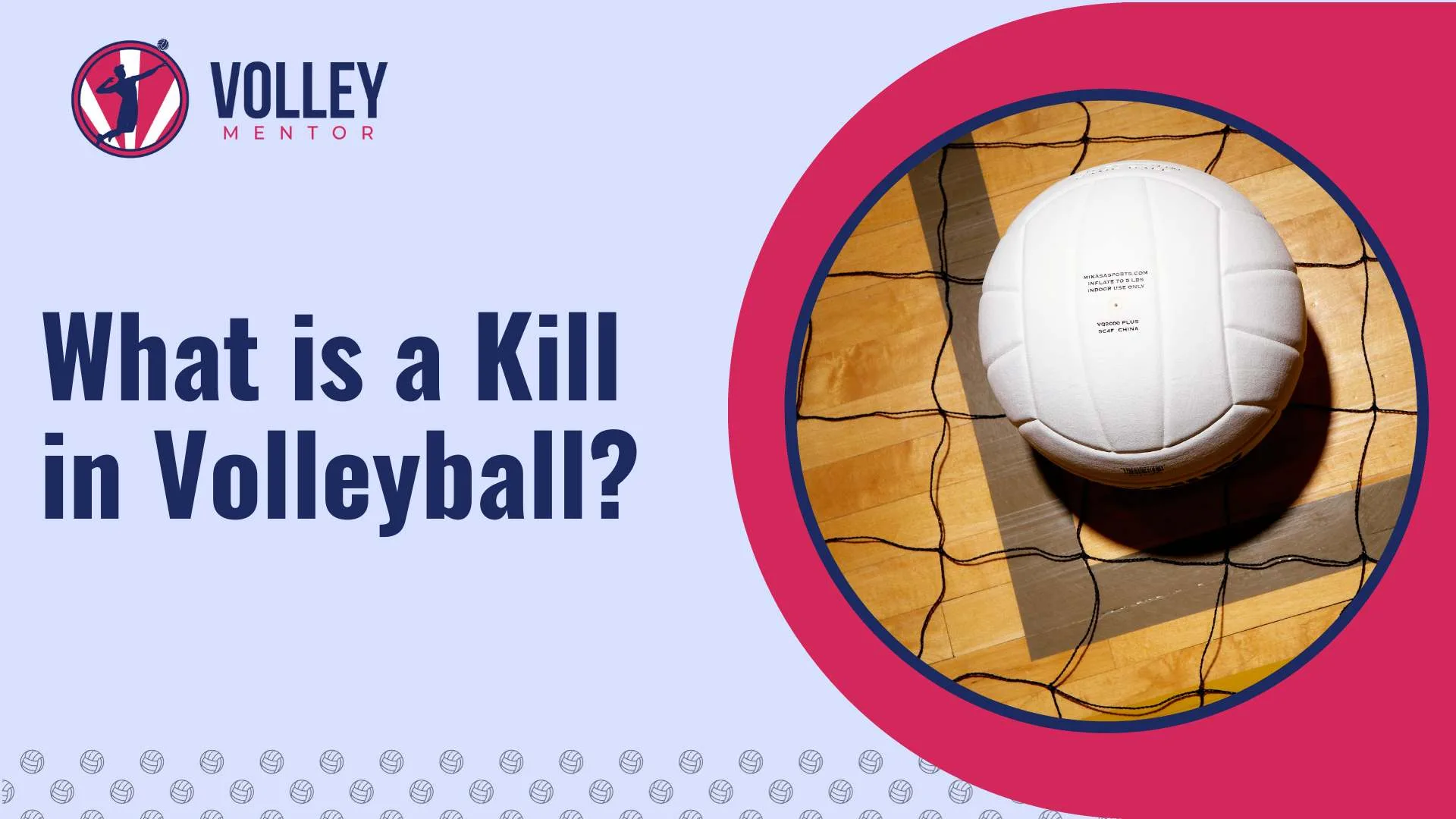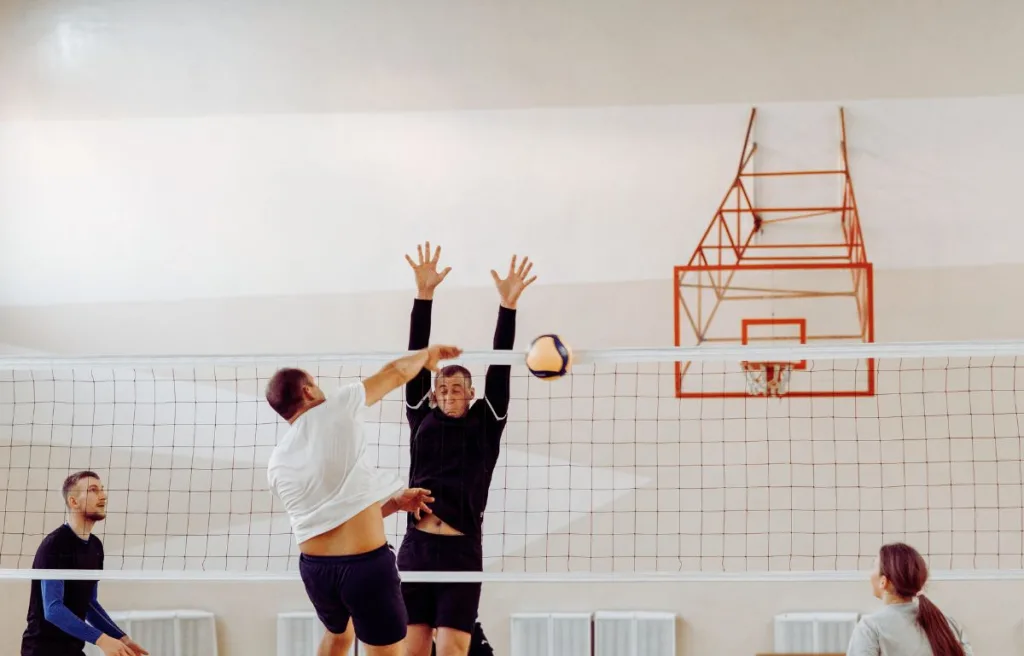What is a Kill in Volleyball? Tips for Effective Scoring

Volleyball is a blend of excitement, skill, and quick thinking.
One of its most thrilling parts is a “kill.”

This term might sound intense, but in volleyball, it’s something players aim for.
But what is a kill in volleyball, and how do you achieve it?
Quick Answer: A kill in volleyball is a successful attack in which a player hits the ball over the net so that the opposing team can’t return it. It results in a point and leads to a sideout for the offensive team.
In this article, I’ll explain its concept in volleyball and then elaborate on what makes a good kill percentage.
Additionally, I’ll share valuable tips and tricks designed to help you achieve more kills in your games, enhancing your overall performance as a player.
What is a Kill in Volleyball?
A kill in volleyball occurs when a player executes a move, such as a forceful spike or a strategically aimed shot, that the opposing team cannot counter.
It represents a moment of victory achieved through teamwork and strategic play.
Also, it boosts the team’s energy and changes the match’s momentum.
Some of the scenarios resulting in a kill could be:
- Powerful spikes: The attacker hits the ball with force, making it hard for the opponents to defend.
- Strategic Placement: Placing the ball in areas where the opponents are not positioned, like the corners of the court.
- Off-Speed Shots: Sometimes, a softer touch, like a roll shot or a tip, can beat the opponent’s defense and result in a kill.
- Counter-Attacks: The defending team quickly transitions to offense, exploiting the opponent’s disorganized defense.
- Blocking: A successful block that sends the ball directly to the floor on the opponent’s side.

Difference between Attack and Kill
An “attack” in volleyball refers to any attempt to send the ball over the net to the opponent’s side to score or continue the play.
It can be a powerful spike, a strategic placement, a setter dump, or a dink.
Not all attacks result in kills.
Some might lead to a continued rally if the opposing team successfully defends them.
A “kill” on the other hand, is a specific type of attack that’s so effective that the opposing team cannot legally return the ball, resulting in a sideout for the offensive team.
It means that although every kill counts as an attack, not every attack leads to a kill.
The distinction lies in the effectiveness and the outcome of the play.
Kill vs Ace: Contrasting Elements in Gameplay
The main difference between a kill and an ace in volleyball is how they occur and their impact on the game.
While kills result from strategic play during a rally, an ace is about serving skill.
An ace occurs when the serve, either untouched or unreturnable by the receiving team, directly scores a point.
It emphasizes the server’s skill and precision and does not involve the back-and-forth action of a rally.
To sum up, the ace highlights the individual serving talent, while the kill reflects the team’s offensive strategy and execution during active play.
What is the Kill Percentage in Volleyball?
The kill percentage in volleyball is a statistical measure that helps measure a player’s effectiveness in scoring kills during a game.
It’s a way to quantify how successful a player is with their attacking attempts.
The formula for kill percentage is straightforward and given below:
Kill Percentage= (Number of Kills / Total Attack Attempts) × 100
Let’s say a player makes 50 attack attempts in a match and scores 20 kills.
Using the formula, their kill percentage would be:
Kill Percentage=(50/20) × 100 = 40%
This means that 40% of their attacks resulted in kills.
While I have just discussed the concept of kill percentage, there is another important metric to mention here.
“Kill Efficiency”
It considers the errors and blocked attacks and gives a more comprehensive look at a player’s attacking effectiveness.
The formula for Kill Efficiency:
Kill Efficiency=[Kills − (Errors + Blocked Attacks)] / Total Attack Attempts
It is helpful because it provides a clearer picture of a player’s performance by considering the negative outcomes of attacks, not just the successful ones.
A higher kill efficiency indicates scoring ability, consistency, and reduced attack errors.

Does a Block count as a Kill in Volleyball?
No, a block doesn’t count as a kill in volleyball, as it is considered a defensive play rather than an offensive one.
In some cases, a block can directly result in a point if the ball returns to the opponent’s court and hits the ground without being returned.
While most people consider it an offensive result, it’s generally categorized separately as a “block point” rather than a kill.
This distinction is important for statistical purposes and understanding players’ team roles.
How to Get More Kills in Volleyball?
To score more kills proficiently, focusing on several key areas is essential.
Each factor contributes to the overall effectiveness of your attack and impacts the game’s outcome.
I have compiled some tips and tricks you can use to get more kills in volleyball.
If you need more clarification on any of the points mentioned below, feel free to ask your questions in the comment section.
1) Mastering the Art of Precision Hitting
Precision hitting is about more than just power.
It’s about placing the ball where the opponents aren’t.
For example, if you notice a gap in the opponent’s court, aim your attack there.
Also, work on diversity in your spike angles and targeting different court areas.
It means doing practice for hitting both cross-court and down-the-line shots.
2) Enhancing Team Coordination and Set-Up
Volleyball is all about teamwork, and scoring those thrilling kills often depends on seamless coordination.
If you are a hitter, having a good understanding and effective communication with your setter is crucial and can help you score more kills.
On the other hand, a setter who skillfully reads the opposing blockers and delivers precision sets to the hitters can unlock a world of scoring opportunities.
So, practice drills focusing on setter-hitter timing, and eventually, they will improve your team’s kill ratio.
3) Adapting to the Opponent’s Defense
Reading and adapting to the opponent’s defense is essential.
It means observing their formation and adjusting your attacking strategy accordingly.
If an opponent is firm in blocking, using off-speed shots or tips might be more effective than hard spikes.
4) Variety in Attack Strategies
Incorporating various attack strategies can increase your chances of scoring kills.
Don’t rely solely on power.
Mix in different shots like roll shots, back-row attacks, etc.
A player who can effectively execute multiple attacks becomes a threat to his competitors.
5) Optimizing Physical Fitness and Agility
Physical fitness plays a significant role in your ability to perform effective kills.
It includes strength, endurance, and agility.
A well-conditioned athlete can maintain high levels of performance throughout the match.
Regular fitness training and volleyball-specific drills can significantly impact the player’s performance.
6) Learn Advanced Jumping Techniques
Mastering advanced jumping techniques can lift your volleyball game to new heights.
These techniques are about more than how high you can jump.
They include learning the right approach, swinging your arms effectively, and timing your jump perfectly.
Consider specific training exercises explicitly made to enhance vertical jump.
These can include plyometric drills and strength training focused on lower body muscles.
Improving your jumping ability can give you an edge over opponents and make you an unbeatable force at the net.

7) Develop Faster Footwork and Positioning
Quick and accurate footwork is essential for getting into the correct position to make a kill.
Good footwork allows for better timing and positioning, making your attacks more effective.
Drills that focus on foot speed and court positioning can significantly improve your ability to be in the right place at the right time.
Remember that being in the correct position is essential for executing optimal kills.
8) Building Mental Resilience and Tactical Thinking
Finally, mental resilience and tactical thinking are as important as physical skills.
A player who can remain focused and make intelligent decisions under pressure is likelier to score kills.
It’s vital to know the game situation and understand the opponent’s weaknesses as a player.
Also, you should know exactly when to execute different types of attacks.
Conclusion
Scoring more kills in volleyball requires smart techniques with consistent practice.
Always remember that improvement comes from teamwork, a deep understanding of the game, and refining your skills.
So, apply these tips in your training and watch your performance skyrocket.
Stay focused, keep pushing yourself, and most of all, enjoy every moment of the game.
Here’s to landing those impressive kills and celebrating each victory with your team!
